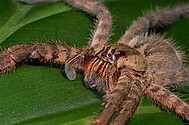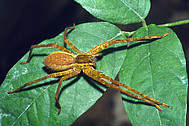Cupiennius - introduction
Spiders of the genus Cupiennius are among the most common and well known spiders of the Neotropics, best illustrated in the book of Barth (2002): A Spider's World. Senses and Behavior.
Nevertheless, the taxonomic (familiar) belonging is still not clear and recently it was excluded from the Ctenidae, without being assigned to another family by Polotow et al. (2015).
The behavior of Cupiennius species has encouraged studies on ecology (Barth et al., 1988; Barth & Schmitt, 1991; Melchers, 1963), electrophysiology (Barth & Holler, 1999; Schmid, 1998; Barth et al., 1993; Land & Barth, 1992), and anatomical ultrastructure (Gorb & Barth, 1996; Seyfarth, 1985; Barth & Libera, 1970), among many others. A key to the species was published by Barth & Cordes (2008).
The only Cupiennius occuring in the Amazon (South America) belong to Cupienniusbimaculatus (Taczanowski, 1874), a species revalidated by Brescovit & Polotow (2005), based on the type of Ctenus bimaculatus Taczanowski, 1874 from French Guiana, and thus being a senior synonym of Cupiennius celerrimus Simon, 1891, based on specimens from Tefé in the Brazilian Amazon.
Only recently, Cupiennius coccineus (F.O. Pickard-Cambridge, 1901) was recorded fo the first time for South America (Colombia, Hazzi et al. 2013).



